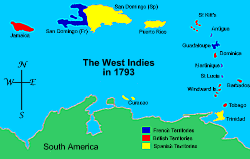 |
 |
 |
Fight to Control the West IndiesRevolt
on San Domingo
Whoever controlled the region would gain the valuable resources of sugar, spices, rum, coffee, cotton and cocoa and, obviously, deny them to the enemy. The majority of islands of the West Indies are located just to the north of the South American continent and run in a semi-crescent from southerly Trinidad to Jamaica in the west and the Bahamas in the north. Britain had long controlled Jamaica and Barbados, it took over Trinidad from Spain in 1797, and picked most of the other islands in the chain with an aggressive policy of military force. London's interest in the islands was no small wonder as the booming trade from the West Indies netted the Goverment more than 4 million pounds a year. With a dominant navy, Britain could land its forces wherever it chose. Between 1793 and 1810 it captured Tobago, Martinique, St Lucia, Guadeloupe, St Martin and French Guyana from the French; Trinidad from Spain; St Bartholomew from Sweden; Demerara, St Martin, Curacao, Surinam and Essequebo from the Dutch and St John, St Thomas and St Croix from Denmark. Islands would change hands several times as the fortunes of war flowed one way then the other, and in 1802 the Peace of Amiens saw Britain having to give up all its conquered possessions (apart from Trinidad). It later reconquered them. While there were very few major battles, casualties were extremely high among European troops as tropical diseases struck with regular brutality. Over a period of a decade, more than 45,000 British soldiers died while serving in the West Indies - with fevers being blamed for almost all of the deaths - and almost as many again were forced out of military service with debilitating conditions caused by the illnesses. On San Domingo, where Napoleon Bonaparte sent some 60,000 men to topple the rebel black leader Toussaint l'Overture, more than 80% had succumbed to yellow fever - including his brother-in-law and expedition commander General Charles Leclerc. |
|
|
Napoleon
Bonaparte
|
|
| Career | Portraits |
| Quotes | Family |
| Loves | Letters |
| Plots | Murdered? |
| His will | Places |
|
Era
of Napoleon
|
|
| Powers | Opponents |
| Coalitions | Allies |
| People | Timelines |
| Key sites | Shrapnel |
|
Warfare
|
|
| Campaigns | Battles |
| Armies | Generals |
| Marshals | Winners |
| Glossary | Medical |
| Weapons | 1812 War |
| Uniforms | Battlefields |
|
War
at Sea
|
|
| Naval War | Heroes |
| Artworks | Signals |
| Nelson | Trafalgar |
|
Maps
|
|
| Key Maps | Peninsula |
| Animated | 1796/1800 |
| 1809 | Russia |
|
French
Revolution
|
|
| Revolution | Guillotine |
| Posters | People |
|
Art,
Film, Games
|
|
| Education | Goya |
| Sharpe | Hornblower |
| Books | Movies |
| DVDs | Music |
| Wargames | Images |
| Cartoons | Caricatures |
|
Other
|
|
| About Us | Sources |
| Awards | Sitemap |
| Links | Militaria |
| Miniatures | Reenactors |
| Forum | Quizzes |
| Home | Waterloo Diorama |
